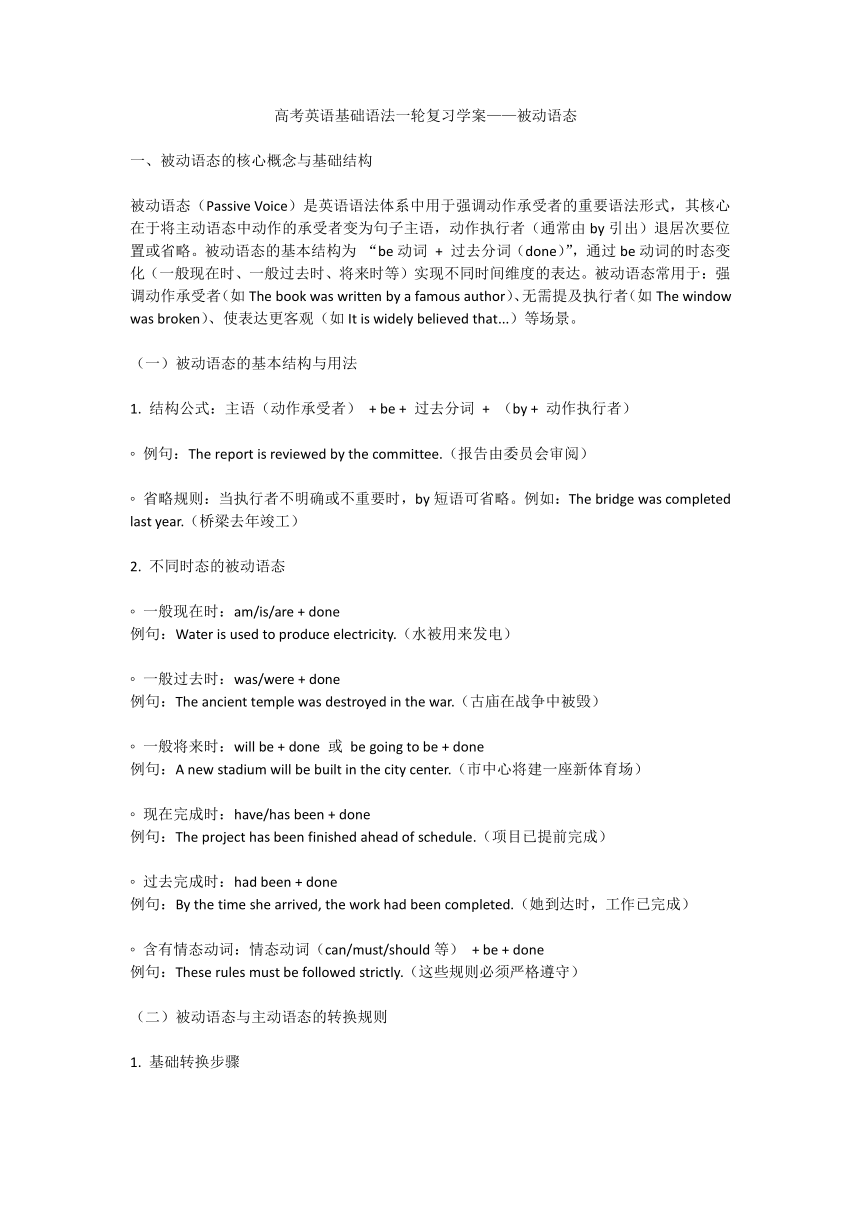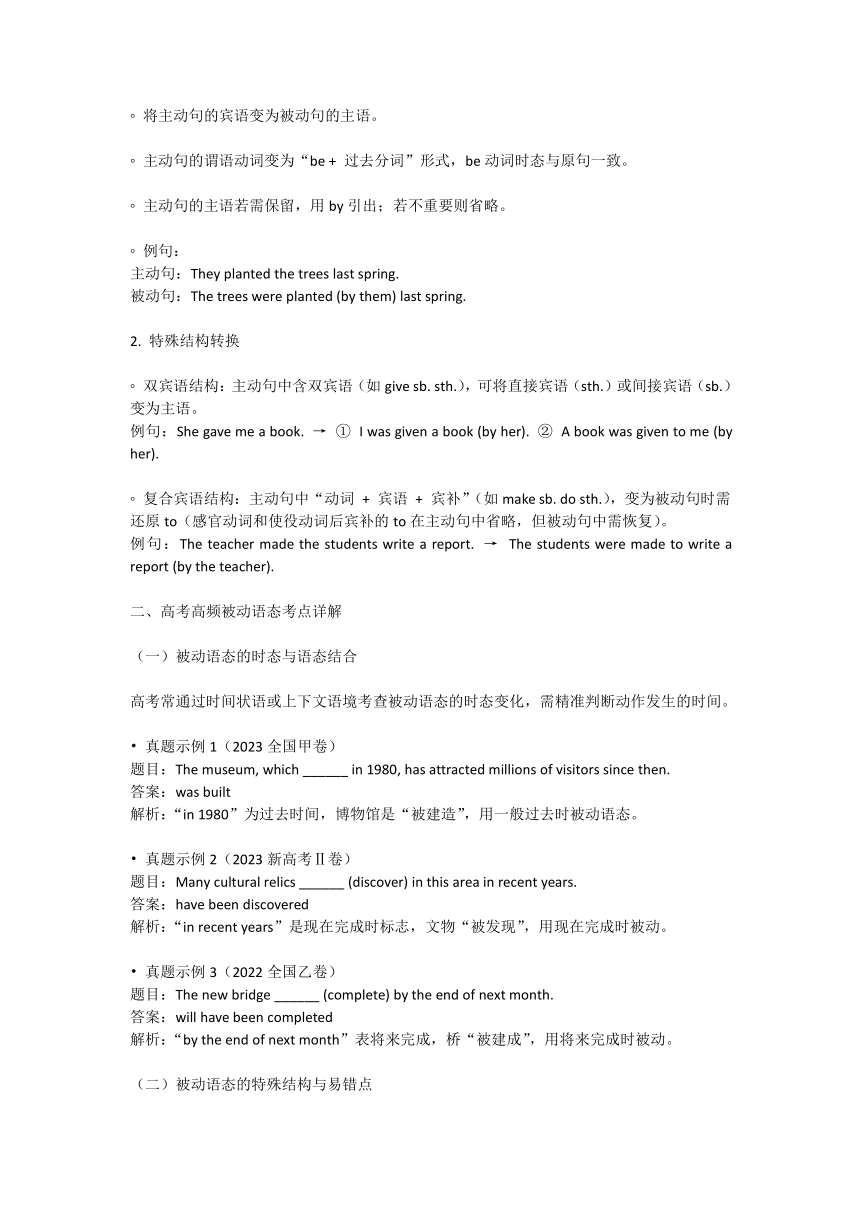高考英语基础语法复习(讲义)—被动语态
文档属性
| 名称 | 高考英语基础语法复习(讲义)—被动语态 |  | |
| 格式 | docx | ||
| 文件大小 | 15.4KB | ||
| 资源类型 | 教案 | ||
| 版本资源 | 通用版 | ||
| 科目 | 英语 | ||
| 更新时间 | 2025-06-20 18:53:38 | ||
图片预览


文档简介
高考英语基础语法一轮复习学案——被动语态
一、被动语态的核心概念与基础结构
被动语态(Passive Voice)是英语语法体系中用于强调动作承受者的重要语法形式,其核心在于将主动语态中动作的承受者变为句子主语,动作执行者(通常由by引出)退居次要位置或省略。被动语态的基本结构为 “be动词 + 过去分词(done)”,通过be动词的时态变化(一般现在时、一般过去时、将来时等)实现不同时间维度的表达。被动语态常用于:强调动作承受者(如The book was written by a famous author)、无需提及执行者(如The window was broken)、使表达更客观(如It is widely believed that...)等场景。
(一)被动语态的基本结构与用法
1. 结构公式:主语(动作承受者) + be + 过去分词 + (by + 动作执行者)
例句:The report is reviewed by the committee.(报告由委员会审阅)
省略规则:当执行者不明确或不重要时,by短语可省略。例如:The bridge was completed last year.(桥梁去年竣工)
2. 不同时态的被动语态
一般现在时:am/is/are + done
例句:Water is used to produce electricity.(水被用来发电)
一般过去时:was/were + done
例句:The ancient temple was destroyed in the war.(古庙在战争中被毁)
一般将来时:will be + done 或 be going to be + done
例句:A new stadium will be built in the city center.(市中心将建一座新体育场)
现在完成时:have/has been + done
例句:The project has been finished ahead of schedule.(项目已提前完成)
过去完成时:had been + done
例句:By the time she arrived, the work had been completed.(她到达时,工作已完成)
含有情态动词:情态动词(can/must/should等) + be + done
例句:These rules must be followed strictly.(这些规则必须严格遵守)
(二)被动语态与主动语态的转换规则
1. 基础转换步骤
将主动句的宾语变为被动句的主语。
主动句的谓语动词变为“be + 过去分词”形式,be动词时态与原句一致。
主动句的主语若需保留,用by引出;若不重要则省略。
例句:
主动句:They planted the trees last spring.
被动句:The trees were planted (by them) last spring.
2. 特殊结构转换
双宾语结构:主动句中含双宾语(如give sb. sth.),可将直接宾语(sth.)或间接宾语(sb.)变为主语。
例句:She gave me a book. → ① I was given a book (by her). ② A book was given to me (by her).
复合宾语结构:主动句中“动词 + 宾语 + 宾补”(如make sb. do sth.),变为被动句时需还原to(感官动词和使役动词后宾补的to在主动句中省略,但被动句中需恢复)。
例句:The teacher made the students write a report. → The students were made to write a report (by the teacher).
二、高考高频被动语态考点详解
(一)被动语态的时态与语态结合
高考常通过时间状语或上下文语境考查被动语态的时态变化,需精准判断动作发生的时间。
真题示例1(2023全国甲卷)
题目:The museum, which ______ in 1980, has attracted millions of visitors since then.
答案:was built
解析:“in 1980”为过去时间,博物馆是“被建造”,用一般过去时被动语态。
真题示例2(2023新高考Ⅱ卷)
题目:Many cultural relics ______ (discover) in this area in recent years.
答案:have been discovered
解析:“in recent years”是现在完成时标志,文物“被发现”,用现在完成时被动。
真题示例3(2022全国乙卷)
题目:The new bridge ______ (complete) by the end of next month.
答案:will have been completed
解析:“by the end of next month”表将来完成,桥“被建成”,用将来完成时被动。
(二)被动语态的特殊结构与易错点
1. 系动词 + 过去分词(表状态而非被动)
部分过去分词(如interested、surprised、excited)与系动词(look、feel、seem等)连用,表主语状态,而非被动动作。
例句:She looks tired after work.(她下班后看起来很累,非“被累”)
真题示例(2021新高考Ⅰ卷):The audience seemed ______ (impress) by his performance.
答案:impressed
解析:“seem + 过去分词”表状态,意为“观众似乎对他的表演印象深刻”。
2. 不及物动词无被动语态
如happen、occur、take place、belong to、break out等,需用主动形式表含义。
例句:The accident happened yesterday.(√);The accident was happened yesterday.(×)
真题示例(2020全国Ⅲ卷):The story ______ (take place) in a small town.
答案:takes place
解析:“take place”为不及物短语,无被动,用主动形式。
3. 主动形式表被动含义
感官动词:taste(尝起来)、smell(闻起来)、sound(听起来)、feel(摸起来)。
例句:The cake tastes delicious.(蛋糕尝起来美味)
动词 + 副词结构:sell(销售)、write(书写)、wash(清洗)等,常用于“物 + 动词 + 副词”。
例句:This type of cloth washes well.(这种布料耐洗)
真题示例(2019全国Ⅰ卷):The book sells so well that it ______ (print) several times.
答案:has been printed
解析:前半句“书畅销”用主动表被动,后半句“被印刷多次”用现在完成时被动。
(三)被动语态在复合句中的应用
1. 宾语从句中的被动语态
若主句为过去时,宾语从句的被动语态需用相应过去时态。
例句:He said that the project had been started.(他说项目已启动,过去完成时被动)
真题示例(2022新高考Ⅱ卷):She believed that the problem ______ (solve) soon.
答案:would be solved
解析:主句“believed”为过去时,从句用过去将来时被动,表“问题将被解决”。
2. 定语从句中的被动语态
关系代词作从句宾语时,从句可用被动结构。
例句:The house which was built last year is very expensive.(去年建的房子很贵)
真题示例(2021全国乙卷):The museum, ______ (locate) in the city center, ______ (visit) by thousands of tourists every day.
答案:located; is visited
解析:第一空“located”为过去分词作定语(= which is located);第二空“博物馆被参观”,用一般现在时被动。
三、高考真题中的被动语态考点剖析
1. (2023全国乙卷)
题目:The old temple ______ (restore) at present and will be open to the public next year.
答案:is being restored
解析:“at present”表现在进行,寺庙“被修复”,用现在进行时被动。
2. (2022新高考Ⅰ卷)
题目:When the car ______ (repair), it will be as good as new.
答案:is repaired
解析:时间状语从句中,用一般现在时表将来,车“被修理”,用一般现在时被动。
3. (2021全国甲卷)
题目:The problem ______ (discuss) at the meeting yesterday turned out to be difficult to solve.
答案:discussed
解析:“yesterday”表过去,问题“被讨论”,用过去分词作后置定语(= which was discussed)。
4. (2020全国Ⅱ卷)
题目:It is reported that another new school ______ (build) in the city next year.
答案:will be built
解析:“next year”表将来,学校“被建造”,用一般将来时被动。
5. (2019全国Ⅲ卷)
题目:The exhibition ______ (hold) in the museum last month attracted many visitors.
答案:held
解析:“last month”表过去,展览“被举办”,用过去分词作后置定语(= which was held)。
6. (2018全国Ⅰ卷)
题目:The classroom ______ (clean) every day to keep it tidy.
答案:is cleaned
解析:“every day”表习惯,教室“被打扫”,用一般现在时被动。
四、被动语态易错点深度总结
1. 时态判断失误:未根据时间状语(如by + 时间点、in recent years)选择正确被动时态。
2. 不及物动词误用:误将happen、occur等词用于被动结构,忽略其主动表义特性。
3. 主动表被动遗漏:未识别taste、sell等词的特殊用法,导致语态混淆。
4. 复合句时态不一致:宾语从句或定语从句中,被动语态时态与主句逻辑矛盾。
5. 系动词与被动混淆:将“系动词 + 过去分词”(如look interested)错判为被动结构。
通过对高考真题的高频考点分析与典型错题归纳,可系统性掌握被动语态在不同语境中的应用规则,提升语法题与写作中的表达准确性。
一、被动语态的核心概念与基础结构
被动语态(Passive Voice)是英语语法体系中用于强调动作承受者的重要语法形式,其核心在于将主动语态中动作的承受者变为句子主语,动作执行者(通常由by引出)退居次要位置或省略。被动语态的基本结构为 “be动词 + 过去分词(done)”,通过be动词的时态变化(一般现在时、一般过去时、将来时等)实现不同时间维度的表达。被动语态常用于:强调动作承受者(如The book was written by a famous author)、无需提及执行者(如The window was broken)、使表达更客观(如It is widely believed that...)等场景。
(一)被动语态的基本结构与用法
1. 结构公式:主语(动作承受者) + be + 过去分词 + (by + 动作执行者)
例句:The report is reviewed by the committee.(报告由委员会审阅)
省略规则:当执行者不明确或不重要时,by短语可省略。例如:The bridge was completed last year.(桥梁去年竣工)
2. 不同时态的被动语态
一般现在时:am/is/are + done
例句:Water is used to produce electricity.(水被用来发电)
一般过去时:was/were + done
例句:The ancient temple was destroyed in the war.(古庙在战争中被毁)
一般将来时:will be + done 或 be going to be + done
例句:A new stadium will be built in the city center.(市中心将建一座新体育场)
现在完成时:have/has been + done
例句:The project has been finished ahead of schedule.(项目已提前完成)
过去完成时:had been + done
例句:By the time she arrived, the work had been completed.(她到达时,工作已完成)
含有情态动词:情态动词(can/must/should等) + be + done
例句:These rules must be followed strictly.(这些规则必须严格遵守)
(二)被动语态与主动语态的转换规则
1. 基础转换步骤
将主动句的宾语变为被动句的主语。
主动句的谓语动词变为“be + 过去分词”形式,be动词时态与原句一致。
主动句的主语若需保留,用by引出;若不重要则省略。
例句:
主动句:They planted the trees last spring.
被动句:The trees were planted (by them) last spring.
2. 特殊结构转换
双宾语结构:主动句中含双宾语(如give sb. sth.),可将直接宾语(sth.)或间接宾语(sb.)变为主语。
例句:She gave me a book. → ① I was given a book (by her). ② A book was given to me (by her).
复合宾语结构:主动句中“动词 + 宾语 + 宾补”(如make sb. do sth.),变为被动句时需还原to(感官动词和使役动词后宾补的to在主动句中省略,但被动句中需恢复)。
例句:The teacher made the students write a report. → The students were made to write a report (by the teacher).
二、高考高频被动语态考点详解
(一)被动语态的时态与语态结合
高考常通过时间状语或上下文语境考查被动语态的时态变化,需精准判断动作发生的时间。
真题示例1(2023全国甲卷)
题目:The museum, which ______ in 1980, has attracted millions of visitors since then.
答案:was built
解析:“in 1980”为过去时间,博物馆是“被建造”,用一般过去时被动语态。
真题示例2(2023新高考Ⅱ卷)
题目:Many cultural relics ______ (discover) in this area in recent years.
答案:have been discovered
解析:“in recent years”是现在完成时标志,文物“被发现”,用现在完成时被动。
真题示例3(2022全国乙卷)
题目:The new bridge ______ (complete) by the end of next month.
答案:will have been completed
解析:“by the end of next month”表将来完成,桥“被建成”,用将来完成时被动。
(二)被动语态的特殊结构与易错点
1. 系动词 + 过去分词(表状态而非被动)
部分过去分词(如interested、surprised、excited)与系动词(look、feel、seem等)连用,表主语状态,而非被动动作。
例句:She looks tired after work.(她下班后看起来很累,非“被累”)
真题示例(2021新高考Ⅰ卷):The audience seemed ______ (impress) by his performance.
答案:impressed
解析:“seem + 过去分词”表状态,意为“观众似乎对他的表演印象深刻”。
2. 不及物动词无被动语态
如happen、occur、take place、belong to、break out等,需用主动形式表含义。
例句:The accident happened yesterday.(√);The accident was happened yesterday.(×)
真题示例(2020全国Ⅲ卷):The story ______ (take place) in a small town.
答案:takes place
解析:“take place”为不及物短语,无被动,用主动形式。
3. 主动形式表被动含义
感官动词:taste(尝起来)、smell(闻起来)、sound(听起来)、feel(摸起来)。
例句:The cake tastes delicious.(蛋糕尝起来美味)
动词 + 副词结构:sell(销售)、write(书写)、wash(清洗)等,常用于“物 + 动词 + 副词”。
例句:This type of cloth washes well.(这种布料耐洗)
真题示例(2019全国Ⅰ卷):The book sells so well that it ______ (print) several times.
答案:has been printed
解析:前半句“书畅销”用主动表被动,后半句“被印刷多次”用现在完成时被动。
(三)被动语态在复合句中的应用
1. 宾语从句中的被动语态
若主句为过去时,宾语从句的被动语态需用相应过去时态。
例句:He said that the project had been started.(他说项目已启动,过去完成时被动)
真题示例(2022新高考Ⅱ卷):She believed that the problem ______ (solve) soon.
答案:would be solved
解析:主句“believed”为过去时,从句用过去将来时被动,表“问题将被解决”。
2. 定语从句中的被动语态
关系代词作从句宾语时,从句可用被动结构。
例句:The house which was built last year is very expensive.(去年建的房子很贵)
真题示例(2021全国乙卷):The museum, ______ (locate) in the city center, ______ (visit) by thousands of tourists every day.
答案:located; is visited
解析:第一空“located”为过去分词作定语(= which is located);第二空“博物馆被参观”,用一般现在时被动。
三、高考真题中的被动语态考点剖析
1. (2023全国乙卷)
题目:The old temple ______ (restore) at present and will be open to the public next year.
答案:is being restored
解析:“at present”表现在进行,寺庙“被修复”,用现在进行时被动。
2. (2022新高考Ⅰ卷)
题目:When the car ______ (repair), it will be as good as new.
答案:is repaired
解析:时间状语从句中,用一般现在时表将来,车“被修理”,用一般现在时被动。
3. (2021全国甲卷)
题目:The problem ______ (discuss) at the meeting yesterday turned out to be difficult to solve.
答案:discussed
解析:“yesterday”表过去,问题“被讨论”,用过去分词作后置定语(= which was discussed)。
4. (2020全国Ⅱ卷)
题目:It is reported that another new school ______ (build) in the city next year.
答案:will be built
解析:“next year”表将来,学校“被建造”,用一般将来时被动。
5. (2019全国Ⅲ卷)
题目:The exhibition ______ (hold) in the museum last month attracted many visitors.
答案:held
解析:“last month”表过去,展览“被举办”,用过去分词作后置定语(= which was held)。
6. (2018全国Ⅰ卷)
题目:The classroom ______ (clean) every day to keep it tidy.
答案:is cleaned
解析:“every day”表习惯,教室“被打扫”,用一般现在时被动。
四、被动语态易错点深度总结
1. 时态判断失误:未根据时间状语(如by + 时间点、in recent years)选择正确被动时态。
2. 不及物动词误用:误将happen、occur等词用于被动结构,忽略其主动表义特性。
3. 主动表被动遗漏:未识别taste、sell等词的特殊用法,导致语态混淆。
4. 复合句时态不一致:宾语从句或定语从句中,被动语态时态与主句逻辑矛盾。
5. 系动词与被动混淆:将“系动词 + 过去分词”(如look interested)错判为被动结构。
通过对高考真题的高频考点分析与典型错题归纳,可系统性掌握被动语态在不同语境中的应用规则,提升语法题与写作中的表达准确性。
